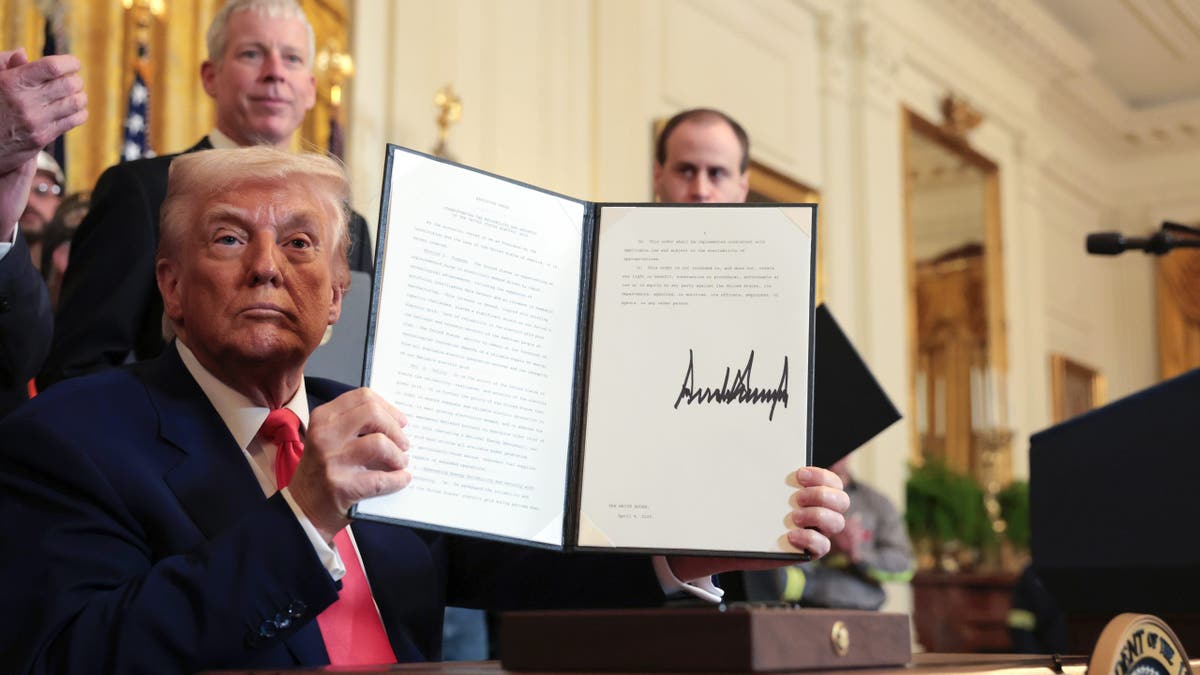

Alaska stands as an American energy powerhouse, a vital gateway to energy dominance, economic prosperity and national security.
The 49th state holds half of U.S. coal resources, the country’s fourth-largest proved crude oil reserves, and the second-largest proved natural gas reserves behind Texas.
On his first day in office, President Donald Trump recognized these untapped opportunities and issued an important executive order, Unleashing Alaska’s Extraordinary Resource Potential.

President Donald Trump holds up an executive order on American energy production after signing it during a ceremony in the East Room of the White House on April 8, 2025. (Anna Moneymaker/Getty Images)
He declared that developing Alaska’s energy resources would help deliver price relief for Americans and create high-quality jobs for our citizens while resolving trade imbalances and bolstering the nation’s exercise of global energy dominance.
ONE STATE’S NATURAL RESOURCES CAN FINALLY PUT AN END TO AMERICA’S RELIANCE ON CHINA
America should not have to rely on foreign energy sources to fuel our cars and heat our homes. It’s expensive, and those countries end up with leverage over the United States.
Anyone who lived through the 1973 Arab oil embargo marked by long gasoline lines and fuel shortages understands this vulnerability.
Producing more of our resources – oil, gas, coal – at home lowers the price of energy used for electricity and transportation fuel, which helps bring more affordable goods and services to Americans.
President Trump’s EO ended the assault on Alaska’s sovereignty and its ability to responsibly develop these resources for the benefit of the nation. He reversed punitive restrictions implemented by the previous administration that prevented the U.S. from producing American energy on both state and federal lands in Alaska, which can now help spark an energy and economic revival.
PRESIDENT TRUMP IS PURSUING ENERGY DOMINANCE — CONGRESS SHOULDN'T GET IN THE WAY
All of this settled in as I traversed the great state of Alaska last week with Interior Secretary Doug Burgum, Energy Secretary Chris Wright, Sen. Dan Sullivan and the state’s governor, Mike Dunleavy.
From the Arctic Coastal Plain to the North Slope, the potential held within Alaska’s bastion of natural resources was clear.
The U.S. Geological Survey says Alaska has at least 160 billion short tons, and possibly up to 5.5 trillion short tons. Yet only one surface coal mine – the Usibelli mine – is operational, supplying about 1.2 million tons annually to neighboring states and Asian allies.
Coal mines also contain critical minerals required for our modern life, a reality unearthed by President Trump during his first term. He has already taken steps to expand sourcing critical minerals for national security.
Alaska is rich in critical minerals including graphite, lithium, tin, tungsten, rare earth elements and platinum-group elements – essential to everyday products Americans demand. Flake graphite, a major component in lithium-ion battery anodes, is currently 100% imported, but Alaska could provide domestic supply.
The state is also an oil and gas titan, yet most of the natural gas produced is not brought to market because of lack of pipeline infrastructure.
During President Trump’s first term, the oil and gas industry in Alaska supported 47,300 total jobs, provided $4.6 billion in labor income to Alaska and contributed $19.4 billion to Alaska’s total gross domestic product, which was more than 35% of the state’s total GDP.
By contrast, the previous administration all but ended oil and gas drilling on the North Slope and canceled the seven remaining leases for drilling on the coastal plains, sacrificing economic growth, energy security, affordable reliable power generation and prosperity for all Alaskans.
AMERICA'S ENERGY CRISIS IS HIDING IN PLAIN SIGHT AND IT'S WORSE THAN YOU KNOW
President Trump’s vision for us to unleash oil, gas, coal and even critical minerals in Alaska could generate billions of dollars in revenue and thousands of high-paying jobs.
Producing this bounty would set us on a path to fulfill President Trump’s vision for U.S. energy dominance.
We can’t afford not to produce Alaskan energy.
I was fortunate to visit with the Chenega Regional Development Group, LLC and native Alaskans of the Chenega tribe on this trip. What struck me was their kindness, resilience and openness to energy development in their state.
While more than half of Alaskans live in Anchorage, Juneau or Fairbanks, most native Alaskans don’t – they inhabit much of the northern and southwestern regions.
Native Inupiat Eskimos in Northern Alaska have said they do not want to be suspended in the 19th century, and most of the 20th when they struggled with no electricity, running water, toilets or sewage management.
They have struggled to stay warm, and in many cases, have nearly died from hypothermia when they lived without adequate energy and home heating.
All Americans must have access to adequate electricity and home heating. Climate activism cannot stand in the way of access to critical energy resources.
We can produce and deliver energy, grow the economy, create jobs and simultaneously protect the environment. It’s not a binary choice. It’s a matter of urgency, humanity and national security.
Alaska’s extraordinary resource potential will help to power the Great American Comeback and lead America into its Golden Age of success.
